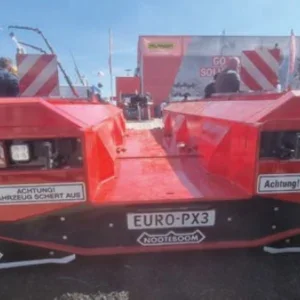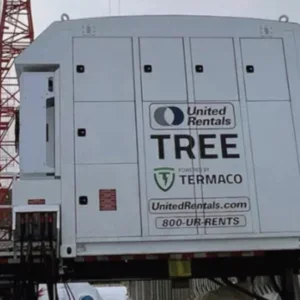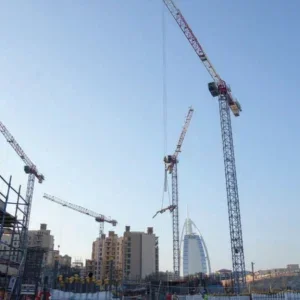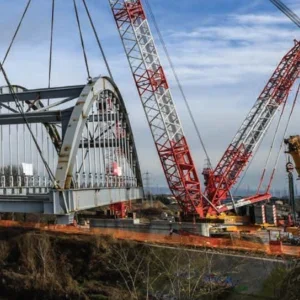The Surtees bridge over the Tees river had been ailing for some time. Concrete on the piers was crumbling at the water line, the bearings were distressed and overrun, the abutments had rotated and the foundations were overstressed.
But until recently the twin two-lane link, carrying the important Stockton to Middlesbrough A66 and vital for daily commuter traffic, HGV goods passage and local interchange, was still just about serviceable. Then the new South Stockton Link Road opened, including a major junction just west of the bridge. It needs more traffic lanes on the A66 for proper functioning, running as far as, and onto, the bridge.
So three years ago the UK road authority, the Highways Agency, with some prompting and finance from the local Stockton-on-Tees Borough Council, decided to replace the five span old structure with a wider, modern three span version at a cost of GBP14.4m (EUR 20m).
Widening and refurbishing the old bridge was considered, but total renewal will allow other upgrading too: capacity will be brought in line with modern 40t truck requirements, a combined pedestrian cycleway can be added, and better ship collision protection provided in the river, which has been navigable since a downstream tidal barrier was built. Work began in February 2006.
The job was not going to be easy. For a start the A66 had to be kept running two ways throughout construction as the old bridge was removed and a new one built in its place. There are two railway bridges alongside constraining the site just downstream. And the particular location of the bridge was in a soft patch of ground.
The material filling it is softer, “a fairly complicated mixture of silts, some stiff to pretty liquid” says Graham Rice, the project manager with A One Integrated Highway Services, a joint venture of consultant Halcrow and road construction contractor Colas. Bridge owner, Highways Agency, appointed main contractor Edmund Nuttall Ltd to undertake the Surtees Bridge replacement work.
Nuttall’s strategy for bridge replacement fell into two interlinked sections, explains Rob Sanger,Nuttall’s site manager: the superstructure, and the foundations and piers. Both would be crane-intensive with mostly prefabricated elements being lifted in and out. In this way the need for continuous working on scaffolding over water and at height could be reduced, which made the job more efficient and much safer.
First the old deck would be cut out and removed on one side leaving about two thirds of the original width in place for reduced traffic lanes, two each way. Then the new piers could be built below in the river. When these were complete, new prefabricated steel and concrete composite deck sections could be put back in place.
Traffic could be moved onto this new wider bridge deck which would allow for two temporary lanes each way if the eventual bicycle path was used as well, and the procedure could be repeated on the other side.
The initial scheme envisaged cutting and lifting out the concrete deck in relatively small pieces with two 500t cranes working from the road deck itself during night possessions.
“But we persuaded them to do the work with a bigger 1,200t Gottwald 680-3” says Paul Weston at Belgian heavy lift crane hire firm Sarens. As luck has it, Sarens’ UK depot location is just 8km away in nearby Middlesbrough, which made it easy to meet with the contract team and discuss the work.
“The two smaller cranes would have required weeks for each section of the work,” he continues, “because it would have needed most of the possession each night to set them up and dismantle again”.
Night closure of the road was allowed for the work, but by rush hour each morning the full road width had to be in use again; at midday this could be cut to single lane running but the big cranes needed the entire bridge width to work from.
The crane
Using the big crane, the second largest in Sarens UK’s armoury, much larger sections of the bridge could be taken out. “The heaviest piece we did was a 334t section at a 33.7m radius,” says Weston. It required 450t of superlift counterweight.
The crane could work at a greater distance, with a maximum main boom of 71m for some of the lifts. That meant it could be positioned off to one side of the bridge so that, despite a very long set up time, it would not interfere with traffic or work on the rest of the site.
“It took them three days to set up for a single lift,” says Sanger in some amazement. “And they had to use 40 trucks to bring the crane to site.”
In fact, says Weston, because the site is so conveniently near the depot–most unusual for a crane which works around the world–just four trucks could be used, each making ten trips.
The crane also had a five day dismantling and re-set-up period to go through for each visit to site because half the work was done from the other side of the river.
Sarens also supplied multi-axle flatbed trailers for moving the sections away.
To use the bigger crane, Nuttall had to add to its foundation work. The soft ground meant piled supports were needed for the crane platform in both positions, with clusters of six driven H-piles installed underneath each of the outrigger positions. “That is where all the load is during lifts” says Weston, “some 300t or more on each.”
Altogether the crane has made four visits to the site, twice for Nuttall and twice for steel fabrication company Cleveland Bridge UK Ltd, which was subcontracted to Nuttall to make the new bridge superstructure elements. First was last summer and then one just before Christmas to lift in the new sections; these were brought to site on multi-axle loaders, also from Sarens.
Four parallel longitudinal girders make up each of three spans for the full 145m length of the bridge on the first side; there will be an additional girder for each span on the other side “because we did slightly less than half the full width for the first section” says Rice.
The new deck girders were fabricated and brought to site in connected pairs with the precast concrete Omniaplank permanent formwork already slotted into place between them. “It is much easier to do at the factory than on site, and did not add too much to the lift weight,” says Sanger. Lifted in elements weighed considerably less than the old sections anyway. Cleveland used GCS Johnson to transport the assembled girder units along the 20km journey from their factory to the site.
Two more Gottwald visits have followed this year to lift out the rest of the old bridge, and install the remaining new sections.
Meanwhile at river level, other prefabricated elements have been used, lifted in by two crawler cranes predominantly. “We have a Sumitomo SC1500 and a Liebherr LR1160 crawler crane for general site work” says Sanger.
Foundations were done by building temporary jetties out onto heavy tubular pile foundations. The 20 or so steel tubes, 1067mm in diameter, have been driven 30m down into sandstone to shoulder massive steel frame jetties above, one each side of the river.
The platforms help cope with difficult ground, and an awkward shape to the river channel, as well as avoiding the need for cofferdams and other complex works.
From these jetties, Dutch subcontractor BAM Grondtechniek installed the main permanent pier foundations, which have been capped.
The bridge structure is now being readied for an autumn opening.
Fixing rebar column into place on the Tees bridge replacement project Fixing rebar column into place on the Tees bridge replacement project Lowering rebar column on the Tees bridge replacement project Lowering rebar column on the Tees bridge replacement project Setting rebar section on Tees bridge replacement project Setting rebar section on Tees bridge replacement project Raising rebar on the Tees bridge replacment project Raising rebar on the Tees bridge replacment project Hooking a rebar column Hooking a rebar column The big crawler lifts a deck section The big crawler lifts a deck section View of the entire Tees bridge without the big crawler View of the entire Tees bridge without the big crawler






